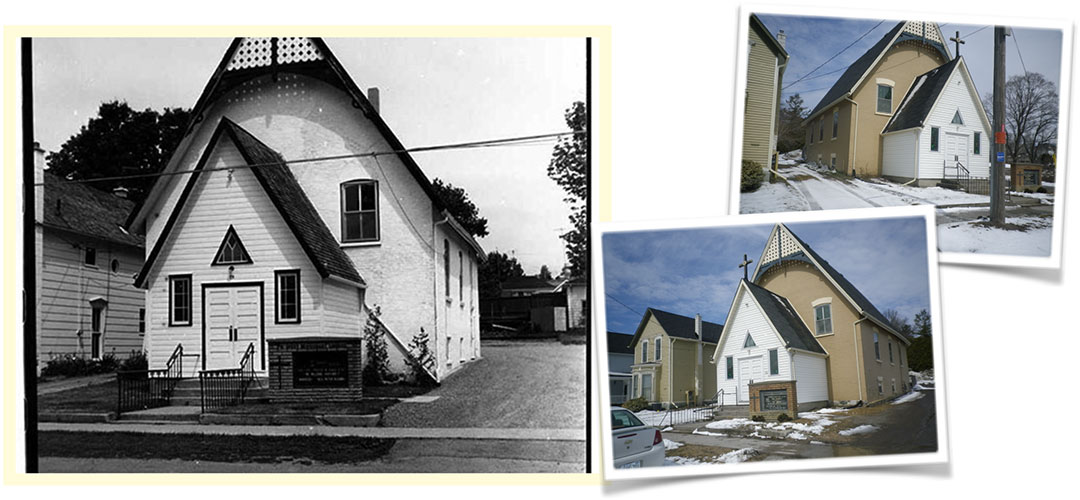75 King Street East, Colborne
Prospect Missionary Church (1944)
Roll No. 1411-012-020-09200-0000 – Cramahe Township Ontario

Wooden Clapboard Church
The building which houses the Prospect Missionary Church was erected in 1869 for a Wesleyan congregation by a contractor named Arthur Elliott. For sixteen years it functioned as a church until, in 1885, the congregation joined with the Methodists. The same contractor remodelled the building into a 12 room house.
In December 1943, the building was purchased by Prospect Missionary Church for $1,500.00. Remodelling began immediately and continued during the spring and summer of 1944. During this period Rev. C.A. Berry became the pastor. By late Fall, the main auditorium was completed. December 9, 1944 heralded the opening and dedication presided over by Rev. R.A. Beech of Vineland, who was District Superintendent. The building was dedicated as Prospect Church. The name “Prospect” was taken from a sign found in the attic.
Near capacity crowds met morning, afternoon and evening on this occasion. Mr. Leonard Gordon, Reeve of the village of Colborne at the time said “….The spirit of our forefathers has not died out. One can feel there are men living who value those higher things in life.”
Offerings for the day amounted to $329.22.
History or Associative Value
For sixteen years, the congregation of this church building was Wesleyan until, in 1885, they joined the Methodists. That union left this building without a purpose. The original builder remodelled it into a 12 room house until in December 1943, the building was purchased by the Prospect Missionary Church and it again became a church.
Additional Historical and Genealogical Information
75 KING STREET Reid Plan 173
This is Prospect Missionary Church lot.
There were numerous transactions through the years involving parts of Reid Lot 173, but the only part of the Lot we are interested in is the southwestern corner, the land on which the Prospect Missionary Church now stands. I am going to limit this discussion to that section of the property.
As with all of the other nearby properties, the early ownership is discussed in the Seaton House write-up. On 22 March 1832, Joseph Abbott Keeler (1788-1855) sold Lot 173 to James D. Goslee (1794-1865), a Colborne entrepreneur and the only child of Matthew Goslee (1757-1830) and Ann Schuyler (1762-1850), the protagonists in the famous Ann Schuyler story. The property stayed in the Goslee family until 1868, sometimes owned officially by James Goslee, sometimes by his son George Goslee (another Colborne businessman, 1823-1882), and sometimes by George’s wife Lucy Goslee (nèe Perry, 1837-1919).
There are some confusing entries in the Land Registry Office at this point. It lists a sale of the property to Andrew Jeffrey on 1 January 1863, with a quick transfer to the Commercial Bank of Canada on 22 February 1863. The Merchant’s Bank of Canada, which had taken over the assets of the Commerical Bank in 1867 (see discussion in the 8 North Street write-up), sold the property to the Trustees of the “M.E. Church” on 11 September 1868. The confusing part is that there is also an entry stating that George and Lucy Goslee sold the property to the Trustees of the Church on 4 November 1868. In either case, the land became Church property in 1868. There is no Andrew Jeffrey in any Cramahe census for the period. The “Hon. Andrew Jeffrey” in the Land Office Records refers to a member of the Ontario Legislative Assembly (hence the “Hon.”) from 1860 to 1863. He lived from 1800 to 1863, was born in Scotland, and resided after 1820 in Cobourg. He was probably involved with this property as a bank official (he was on the Board of the Northumberland and Durham Savings Bank).
“M.E. Church” is an abbreviation for the Methodist Episcopal Church. “How Firm a Foundation” refers to the original church on the site as “Wesleyan Episcopal”. This is confusing to me. As I understand it, the Methodists were divided into two camps: Wesleyan and Episcopal. I don’t know what a “Wesleyan Episcopal” is. The Land Records Office documents indicate that the church on Lot 173 was an Episcopal Methodist Church, not Wesleyan Methodist.
According to “How Firm a Foundation”, the church was built on the site in 1869.
The Episcopal Methodist Church formed in 1784 as a separate entity from the church founded by John Wesley (1703-1791). The two denominations rejoined each other in Canada in 1884 to form the Methodist Church of Canada. At this point all Methodists in Colborne shifted their place of worship to the Wesleyan Methodist Church, currently the United Church. The Methodist Episcopal church on Lot 173 was sold to our old friend Daniel Lewis Simmons (1830-1915) on 23 April 1885. There are no further sales recorded before 1921 in the Registry records, so apparently the property stayed in the Simmons family after Daniel Simmons died in 1915. “How Firm a Foundation” says that the church was remodelled into a dwelling, which it was to remain until it became the United Missionary Church in 1943.
“How Firm a Foundation” says that one of the tenants while the building was used as a residence was Margaret J. Hinds, vice principal of the Colborne High School. I am not sure this is correct: she owned the northern part of Lot 173 and the adjacent northwestern part of Lot 172 from 1906 to 1920 and is listed as resident of Lot 172 in 1911. Perhaps she was resident in the old church before 1906. Otherwise it looks like she may have been resident on a property to the north of the church. There is no one listed in the 1911 census as present on Lot 173, but then the census is not complete in its listing of addresses in Colborne.
75 King St E, Colborne, ON K0K 1S0, Canada
